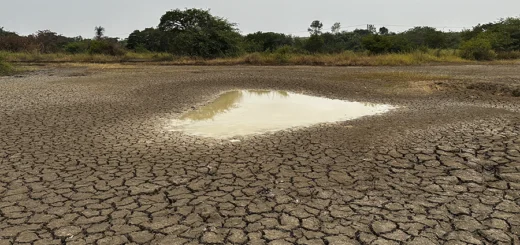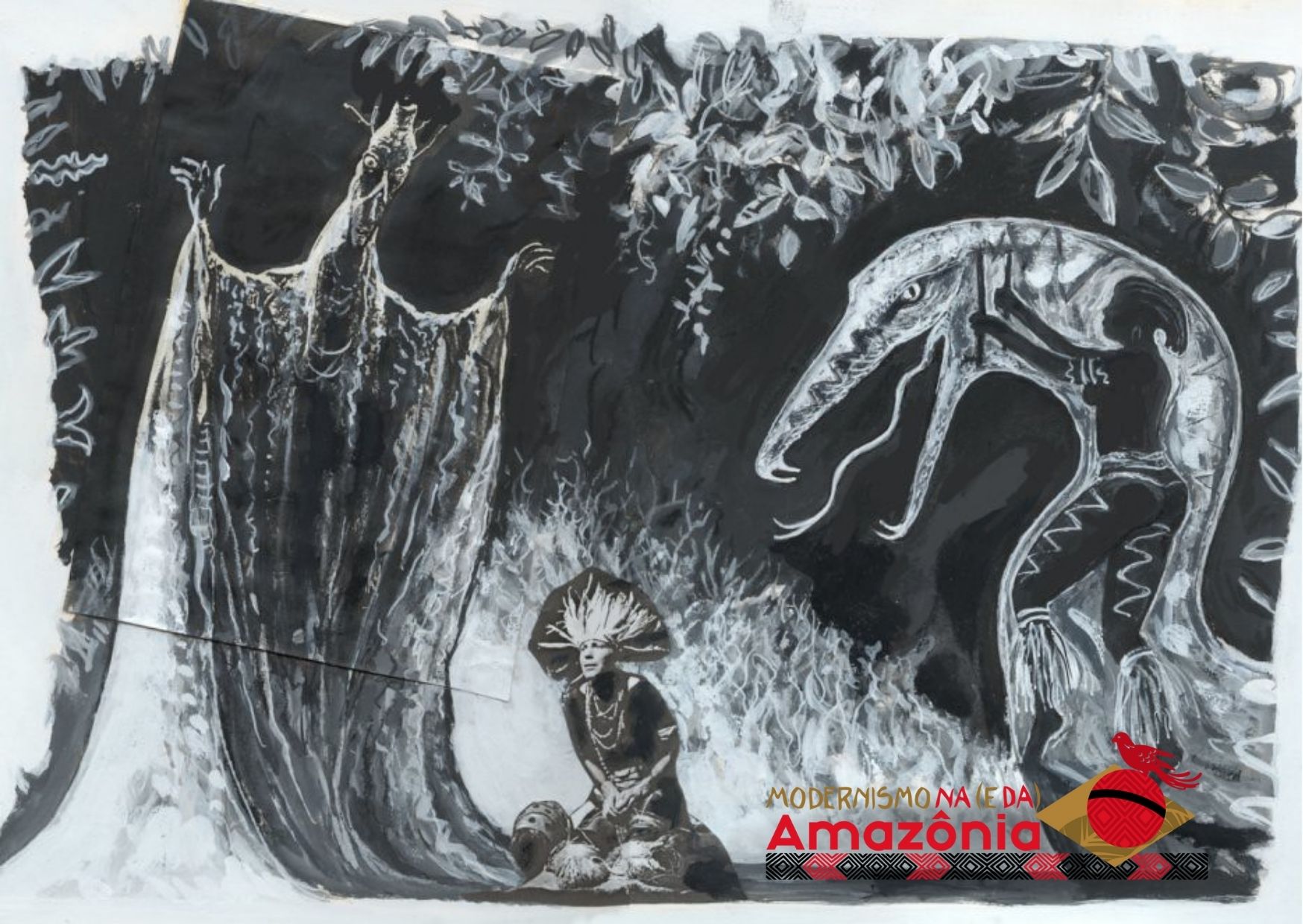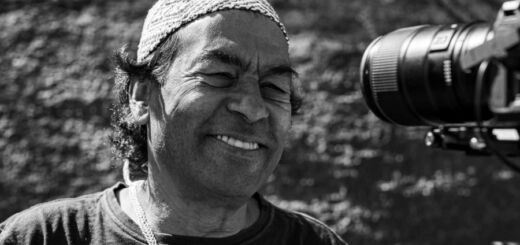Jorge Bodanzky Revisits Cinema Novo’s Iconic Iracema

The director discusses the challenges of creating Iracema and states that the issues that the film exposed are exacerbated today.
The Trans-Amazonian Highway was built and completed in 1972, under Brazil’s military dictatorship. This massive project was meant to connect the Amazon to the rest of Brazil, symbolically and physically creating a Brasil Grande (Big Brazil). By physically attempting to unify the nation, the Amazon and its peoples became subject to capitalistic exploitation, experiencing loss of identity through modernization and destruction of the natural landscape.
Jorge Bodanzky’s film Iracema – Uma Transa Amazonica (1975) embodies the negative impact of the highway by following a young coboclo prostitute, Iracema, as she journies along its path with a trucker, a patriotic man that goes by the moniker “Tião Brasil Grande.” Influenced by Italian Neorealism and the French New Wave, Bodanzky uses Cinéma vérité techniques to create a story that blends fiction with documentary. The final result is a film that serves as a hallmark of the Brazilian Cinema Novo movement of the 1960s and 1970s.
Iracema was invited to screen at the International Critics’ Week during the 1976 Cannes Film Festival, where it received critical acclaim and found international distribution. The film’s unflinching depiction of the tragic realities of Amazonians shocked global audiences, and its nuanced portrayal of Iracema’s downfall—interspersed with documentary footage of the Amazon’s destruction—demonstrates the havoc the massive highway project presented to the communities surrounding it.
In this interview, Bodanzky discusses the challenges of creating Iracema and asserts that the issues the film exposed then are exacerbated in the present day.

Florida State University students interviewing director Jorge Bodanzky, who co-directed “Iracema” with Orlando Senna
How did you come up with the idea to make Iracema?
I came to the idea for the film because I worked as a photographer for the Brazilian press and I was sent to the Belém-Brasília Highway for a project that fell through. The reporter I was with decided to leave and explore the region, and he left me at a gas station for a couple of days. During those two days, I would observe the station, and I started noticing some things. At daytime, it was a normal gas station, with the truckers fueling and doing maintenance on their vehicles. At night, though, it was another situation. Those same truckers were back, but for different reasons—it turned into a brothel! I found that to be curious, so I told myself, “If I tell the story of this highway, I will include these people, the truckers and prostitutes.”
That was the beginning of this idea. It took six years to convince my producer to make this film, but before agreeing he asked for something concrete. So I went back to Brazil with my partners, Wolf Gauer [Associate Director] and Orlando Senna [Co-Director] to capture the essence of this story with some sample footage. We went in my little punch buggy from São Paulo to Belém-Brasília, then to Marabá, then, finally, we entered the Trans-Amazonian Highway.
This was 1963, it was a dangerous time because of the military dictatorship. The Trans-Amazonian Highway was a protected zone that you weren’t allowed to enter. But we went anyway, and I used my Super 8 camera as a diary and notebook. While we were interviewing people, I saw the story come to life, everywhere we stopped Iracema was there. I took the Super 8 film and showed it to the German producers and they said “If you promise us you will put these images in your film, we will fund it.”
It was made for a German TV Network. It was a part of an experimental programming block that broadcasted late at night—around eleven or midnight. We had a small budget from them, it was an experiment for the station. So we went and filmed it, but didn’t think it would be anything more than that. [Laughs] In fact, the day it was supposed to air on the German network, the other major German channel was playing a big soccer match. I thought, “Everyone will want to watch soccer, no one will want to see Iracema.” [Laughs] But sometimes there are lucky moments that happen in life. When the day came around, there was a great snow storm, and the soccer match was canceled. So everyone who watched TV that night ended up watching Iracema! [Laughs]
Did you get any inspiration for Iracema from different Brazilian movies at the time?
Of course, the environment you’re in always has an influence on you. I was a member of the Sociedade Amigos da Cinemateca in São Paulo, and I saw a lot of new Brazilian films, especially Cinema Novo and Brazilian documentaries. They were helpful in exposing me to certain techniques and narratives, but my greatest influence is Jean Rouch. I’m a great admirer of his work. I identify immensely with the way he shoots films, even today. And of course, direct cinema, the use of direct sounds, reporting, hybrid styles of fiction—all of these things influenced me.
How was Iracema received at first?
After it first aired on German TV, critics talked about the film, and buzz started generating. Other critics read about it, and they would watch the film, too. Jean Rouch saw it! Eventually, Iracema was invited to the Cannes Film Festival as a part of the Critics Choice Category. But we had a problem. The film was shot in 16mm. That’s just the way TV documentaries were shot back then, before digital. Cannes did not accept 16mm, only 35mm films. So we had to somehow blow up our film from 16mm to 35mm, which is an expensive process. Additionally, the system we used to edit the film didn’t give us enough quality, so we needed specialized work. Eventually, we found a laboratory in England who could fix our problem, and we hired them to help. Once they did, we were able to blow up the film, and it looked very, very nice. Today the film people watch is the version from this lab. After the Cannes screening, the film became widely known, and was invited to be played in many other countries.
You can imagine, I had no money back then! [Laughs] I was in Europe, took a car, went to Cannes to see what would happen. I was thirty years old. We were sitting at the cafés, smoking cigarettes, feeling like real big shots. [Laughs] And then a distributor came up to us, she was the same person who was in charge of the distribution of other big names like Glauber Rocha, and so on. And she said, “You sign here; I’ll give you $10,000 and distribute your film.” Well, I was broke, I didn’t even have money to stay at the hotel. To me that was a fortune! So of course we signed, and the film was distributed. After that moment I never saw another cent from this film. It was played all over the world, and we never got paid for it.
Iracema captures audiences because of its authentic portrayal of the Amazon and its peoples, why do you think that is?
Because of our unique cast, we were able to film scenes very authentically. When we imagined a scene, we imagined what could happen and tried to incorporate the real-life people that were there. Sometimes these shots wouldn’t work, but we didn’t try to repeat them in the same place. Instead we would choose another place and try it again. The film has a lot of non-actors, just ordinary people who we encountered, and with people like that you shouldn’t try to repeat a shot. With non-actors, it’s only the first moment, and for me that was very important. If we couldn’t capture the authenticity of the first moment, then we would move on and try again somewhere else. One of the few professional actors was Paulo Cesar Pereiro who plays the main truck driver, Tião Brasil Grande. In Brazil, most drivers have special accents because they are southern, gauchos [Southern Brazilian cowboys], or from Santa Catarina. Luckily, Pereiro is from the south, so he already had this accent. When he was acting, people didn’t suspect that he wasn’t a driver because he spoke like a driver. And Edna de Cássia who plays Iracema is a local. So it was the ideal situation to provoke the participation of the non-actors because they thought they were speaking with real people.
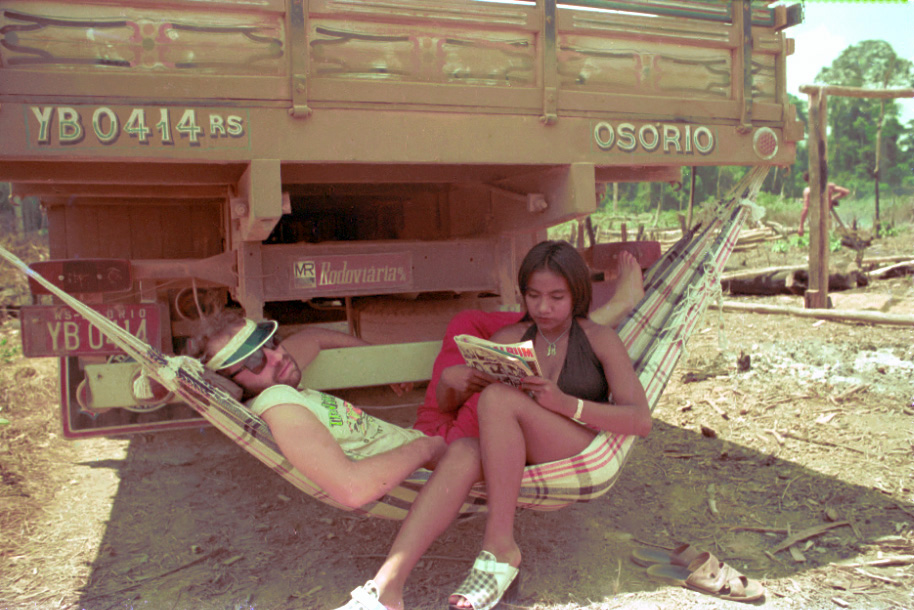
Paulo César Pereio was one of the few “real actors” in the movie “Iracema”. (Jorge Bodanzky/Amazônia Latitude)
How did you find Edna de Cássia, the girl who plays Iracema?
Orlando and I wanted to have a very young girl, who was the same age as the character in the film. We wanted to show the reality of what was happening at the time. There were very, very young girls who took this journey with truck drivers through the Trans-Amazonian Highway. Additionally, we wanted for the girl to have an indigenous background, a caboclo, as we say it. It could not be an actress from the South of Brazil. I thought it was going to be very difficult to find this kind of person for the role, because she had to be fourteen or fifteen years old max.
So we went to Belém, and gave ourselves ten days to find the girl. We searched around the city, the college, the clubs, and so on. We’d be walking the street, see a girl, and think, “Oh, this is her! This is Iracema!” But as soon as we started talking to her, we would see that it was impossible to get her for the role. You see, there was another condition, one that was very difficult. It had to be a girl whose parents gave authorization to do the job. But on the last day, we still didn’t have the girl. We asked our Taxi Driver for help, and he took us to a radio hall, where groups of young people would gather around. When we arrived, there were 200-300 people—all skipping school! [Laughs]
The moment I entered, I saw Edna. She had to be Iracema, she had such brilliant eyes. I told Orlando to go speak with her, and he brought her back. He asked, “What should we have her do?” And I told her: go to the market and buy something for yourself. I’ll give you a little money, just let me snap some photos of you while you shop. So we went to Ver-o-Peso, the big market in Belém. She was looking around, and I was taking the pictures. Then, while taking photos of the location, I suddenly hear a loud commotion. I turn around and see a woman yelling at Edna. So I walk up to them, and I ask, “What’s happening here?” And Edna says, “Oh, it’s just my mother! She’s angry I’m not at school right now.” [Laughs] I immediately think: oh, so we found the mother! Exactly what we needed! It was a lucky moment.
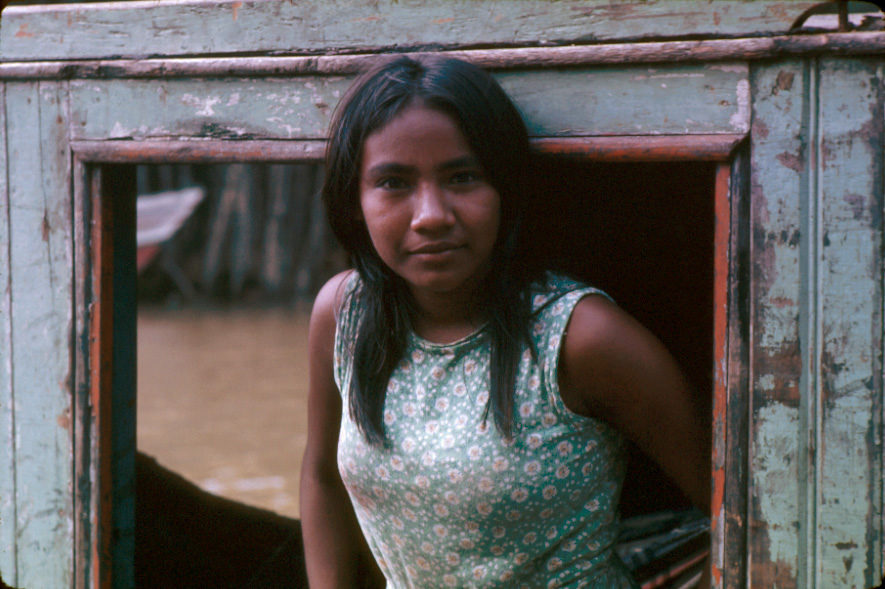
Edna de Cássia, “Iracema”‘s star, had never acted in a movie before. (Jorge Bodanzky/Amazônia Latitude)
How was it working with Edna?
She came from a very poor area outside Belém. She had never even been to a cinema! She had never seen a film, only television. But it didn’t matter. So we went through all the formalities, the parent’s gave us permission to shoot with Edna. We left, and we came back eight months later. We paired her with Conceição Senna, who was a professional actor in the film. Senna played the role of the woman who took care of Iracema. We stayed at a very modest little hotel outside of Belém. We had Edna live in the hotel with our team, to build chemistry. And it worked out very well!
Edna is exactly the same in real life as she is in the film. During production she would speak passionately, make funny commentary about everything, give everyone on set nicknames! [Laughs] Today, she is the same person. I got to meet up with her last November in Belém when we did a small exhibition of photos I took during that time. She showed up, and her voice is still exactly the same!
In Iracema, years go by for Edna’s character in a matter of scenes. It can be disorienting for the audience, but it effectively places us in Iracema’s shoes. Why did you choose this technique?
We wanted to show what happens normally when young girls enter prostitution. It’s a horrible situation, and they are stuck. As they get older, they find themselves physically destroyed. It’s tragic, and it happens to all of these young girls. It’s a sad story that is often seen in this area. They never get a chance to have a normal life.
Also, we had a very, very low budget. Extremely low budget. So we had to shoot this film in fifteen days. We had time to prepare before, of course, but shooting itself, we had no more than three weeks. And we had to show this transformation. We had to show the audience that years passed—in fifteen days. [Laughs] But it worked! Because all the locations we needed to film at were around us. We didn’t need to travel far to go anywhere. The final scene was made, more or less, around the same place as all the other scenes. We didn’t have to voyage hours from one place to the next.
There’s a very harrowing scene in the film where we see fire engulfing the Amazon. What made you want to include these very real visuals in your film?
During production, the region was always on fire, it surrounded us constantly. We had gotten so used to the blaze that we almost forgot to get a shot of it before we wrapped! When people in Europe saw this clip, they were astonished with the image. It was the first real view of the Amazon on fire that they had seen. At that time, the burning of the Amazon wasn’t really discussed. And so we were there, during the beginning of this conversation.
Was there any particular scene in the film that was more difficult to shoot?
No, there was not a scene that was necessarily difficult, but the closing scene was a bit more dramatic. I was in a situation where I was almost out of film stock to shoot on, and so I had to film the last scene in single takes. [Laughs] Every five minutes, Wolf would have to change the stock as I was filming in order for me to shoot continuously.
I had no control over the scene, non-actors were on set, and we had to use a real trucker to drive the cargo truck, because Pereio didn’t have his license. So we had to do this scene rather spontaneously, and in real time. When you see the truck drive away at the end of the film, the real truck driver is actually driving away from us—he didn’t come back! [Laughs]
The prostitutes [non-actors] in that scene—I had no control over what they were saying or doing, they were just being themselves. The only person who maybe had a little sway on the situation was Pereiro, who was improvising and helping steer the conversation. Beyond that, the scene was very genuine and unique.
Speaking of difficulties, how did the dictatorship affect the making of your film? Were you afraid?
No, I was not afraid. I was young then, naive. [Laughs] Today, I would think ten times before I made a film like this. Back then, I was working as a cameraman for European TV networks stationed in Brazil. And there was a moment then when a lot of countries in South America were turning into dictatorships. So we would film these moments in Chile, Argentina, Paraguay, Bolivia—I was there as a reporter. And I was filming with the same camera that I shot Iracema with.
So I had a lot of experience shooting in dangerous situations, especially political situations. One technique was to be very, very fast. You don’t ask—you go, shoot, then leave to the next location. If you stay in one place too long, people will notice you. They’ll forbid you, kick you out, try to take your camera, and so on. And this was the same technique I used in Iracema when we shot it. We were always on the go. If we didn’t get what we wanted in one location, we would try in another way, at another place. But we would never repeat it in the same place with the same person. And that’s how we were able to slip under the nose of the military regime while filming. Nobody said a word to us, because we went very, very fast. [Laughs]
What difficulties did you have distributing your film in Brazil after its success abroad?
The military regime was always discrediting our project. They would say, “Oh, it’s not a Brazilian film. They didn’t use Brazilian laboratories to develop the film.” They always would say that. When the film screened at Cannes and was shown on German TV, the Brazilian embassy would tell them they couldn’t use the term “Brazilian Film.” We didn’t care, at first. “Call it what you want,” we thought. “It’s not a Brazilian film? Okay, then call it a Panamanian Film. Who cares!” To us it was all the same thing. [Laughs]
But, whenever we tried to show it officially at a competition or exhibition in Brazil, censors wouldn’t allow our film to be played because it was “not a Brazilian film.” One day, I got fed up and packed the full 60 meter roll of the film in my suitcase, and traveled to Brasília. I went to the Ministry of Justice, where the censors were located, and I placed the film on the counter and said, “Here’s the film. Please, analyze it. Tell me: what can I show, and what can’t I show? I want it on the record.” They immediately waved their hands and said, “Oh no, we can’t analyze this because it’s not a Brazilian film.” [Laughs]
So how did people in Brazil see Iracema?
I didn’t wait to show the film, or release it officially. At that time in Brazil there were a great number of Cine Groups [film clubs] that were set up by social civil organizations, student associations, church communities, journalism societies, and MDAs [Movements for the Defense of the Amazon]. All of these different groups had well organized film screenings as a response to censorship. It was a form of underground resistance. We were able to make copies of the footage and distribute them to these groups, so the film circulated the entirety of Brazil. By the time the film made it to movie theaters [after the end of the military regime in 1985], there was a whole generation of people who had already seen the film. Iracema had great circulation and I was not worried about officially being able to show the film.
It seems your films tend to have a political edge, and sometimes clash with the current political regimes. Are you tired yet of sticking it to the man?
Absolutely not. I make exclusively political films. For example, the film I’m making now, it’s about mercury poisoning in the rivers of the Amazon basin. Extremely political. It’s happening right now and it’s a major crisis. The Amazon is being invaded by illegal mining, and the mining proposals are controlled by the politicians. Not only by local politicians, but by Bolsonaro [Brazilian President] himself. He actively promoted this illegal mining because it provides income to his electors, who ultimately are more inclined to vote for him, especially this year [2022 presidential election]. He wants all the votes of this population. So he completely unleashed industry in this region. You can do what you want now: occupy indigenous areas, enter sanctuaries, take gold from wherever. Each place he opens up is just a political move to get more votes. But it’s not only this, it’s his philosophy. He believes that the Amazon must be used economically, in a bad way. Not in an organized way, but in the illegal and absurd way he’s doing now. So I actually think that this new film is perhaps the most political film of my career.
If you were to shoot Iracema again today, would you change something?
No, no. I wouldn’t change anything. I recently made a series for HBO with six, hour-long chapters that each chronicle the Trans-Amazonian Highway. I revisited all these themes again. The highway didn’t change, and I didn’t change my point of view. It’s important to say these things. Yes, as we get older, we gain more perspective. But my view of the situation and how I tell it today, it is the same as I told it then. So if I were to shoot Iracema again, I would shoot it very similarly, because I continue operating with low-budget productions today. The reality is I shoot my films myself, and I work with mostly non-actors. So it would be very similar.
But, to be honest, it’s impossible to shoot Iracema today. First, because you can’t use a minor to film such a movie. The law doesn’t allow it. Second, it’s too dangerous. At the time, it was dangerous too. We had the military dictatorship. If they had discovered us, we could have been arrested. But today there is gang violence. We wouldn’t get arrested, we’d get shot! [Laughs] And third, information travels more rapidly today. Everyone has a phone. If they see us making a critical film like that, they can contact someone instantly. And when you go to the next place, everyone would already know who you are and what you are doing. It was different then.
Jorge, thank you for this conversation. Before we go, what’s the most important thing that you want people to take away from it? What image do you want them to have of the Amazon?
Iracema shows everything: the occupation, the slave workers, the prostitution, the violence. All the issues that Iracema exposed are worse today. What’s happening in the Amazon is really a project that began under the military dictatorship and continues even under a more democratic government. They didn’t change their point of view on the Amazon. The occupation there continues under the same philosophy as the military dictatorship during the 60s. For me, the most important thing isn’t the film itself, but what the film showed. I wanted the film to contribute to the discussion about what’s happening in the Amazon. So, I’m very happy to see that even 40 years after it was filmed, Iracema continues to provoke this discussion.
Interview conducted by undergraduate students at Florida State University’s “Film Travel Narratives: A Road Map to Amazônia(s)” course offered by Marcos Colón in the Spring Semester of 2022. Moderated by Alyssa Ackbar (International Affairs) and André Mancebo Heizer (English, Writing, and Media), students Mariana Dos Santos (International Affairs & Interdisciplinary Social Science), Milena Watt (Art History), Chris Ahrendt (Digital Media Production), and Giovanni Grossi (International Affairs) all participated in this interview.
Featured image: Jorge Bodanzky films “Iracema”, in 1974, which he co-directed with Orlando Senna. (Jorge Bodanzky/Amazônia Latitude)
Leia aqui a entrevista com Jorge Bodanzky em português.


